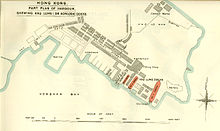Hong Kong and Whampoa Dock
This article needs additional citations for verification. (January 2018) |



Hong Kong and Whampoa Dock was a Hong Kong dockyard, once among the largest in Asia.
History
Founded in 1863 by Douglas Lapraik and Thomas Sutherland,[1] the Hong Kong and Whampoa Dock Company (known as Hong Kong Kowloon and Whampoa Dock Company). In 1865, it was known as Kowloon Docks located on the west Kowloon coast between Hung Hom and Tai Wan, facing Hung Hom Bay in the Victoria Harbour. It is also known as Whampoa Dock for short. The "Whampoa" part of the name comes from the Huangpu (previously transliterated as Whampoa), area of Guangzhou (previously transliterated as Canton), where the company owned another dockyard.
On the eve of Japanese occupation of Hong Kong, the dockyard was heavily bombarded by Japanese aircraft due to its importance, causing many casualties.
In the mid-1960s, the Hong Kong and Whampoa Dock Company was controlled by Douglas Clague through Hutchison International but he was forced to leave following financial difficulties with Hutchison International. Hutchison International was acquired by Li Ka Shing's Cheung Kong Holdings and eventually merged with Whampoa to become Hutchison Whampoa. In 1985, the dockyard land was transformed into a private housing estate, the Whampoa Garden, the second-largest private housing estate in Hong Kong, after Mei Foo Sun Chuen. The only portion of the dockyard that exists is Bulkeley Street.[citation needed] The dockyard is now part of the Whampoa Garden site residential complex.
The dockyard operations merged with Swire's Taikoo Dockyard on the Island to become Hong Kong United Dockyard on the new territories western shore of Tsing Yi Island Wok Tai Wan.
Hong Kong and Whampoa Dock helped converted Hong Kong Tramways second and third generation tram cars built by United Electric and English Electric. These cars were eventually retired from 1924 to 1930 as the fourth-generation cars were introduced.
Other facilities:
- Hope Dry Dock in Aberdeen, opened 1867.
Ships
Ships built at this yard include:
- USS Mariveles (1886)
- USC&GS Fathomer (1904)
- Kwai Sang (1917)
- S.S Suddhadib 1918 (Maiden voyage; Hong Kong 22 April 1918)Built for the Siam Steam Navigation Company (part of the East Asiatic Company (EAC) - Bangkok-based, Danish owner) Shipwrecked: 01-06-1945 Allied Bombing - Siam Bay.
- S.S Valaya 1918 sistership to s.s.Suddhadib above.(Maiden voyage; Hong Kong June 15th )Built for the Siam Steam Navigation Company (part of the East Asiatic Company (EAC) - Bangkok-based, Danish owner) Shipwrecked: 13 Jan 1944(sunk by mines in the mouth of Chaopraya River 1944)
- SS Changte (1925) for Australian Oriental Line; later became Royal Navy Naval Stores Issuing Ship RFA Y1-9.[2]
- Sang Wo (1926)
- SS Taiping (1926) for Australian Oriental Line[2]
- Li Wo (1938); 1,000 ton passenger ship later converted as a patrol vessel for the Royal Navy; sank near Singapore in 1942 as HMS Li Wo.[3]
- HMAS Matafele (1938)
- SS Empire Almond (1941)
- SS Gyōkū Maru (1942)
- and many of the Hong Kong Star Ferry vessels in service today.
See also
References
- ^ Swiggum, S. (2013). "Douglas Steamship Company, Ltd". theshipslist.com. Retrieved 10 June 2013.
- ^ a b Wildy, Merv (14 July 2003). "Allied Chinese Ships WWII". Archived from the original on 29 October 2003. Retrieved 24 October 2010.
- ^ "The story of HMS Li Wo and her crew". forcez-survivors.org.uk. 2012. Retrieved 10 June 2013.
